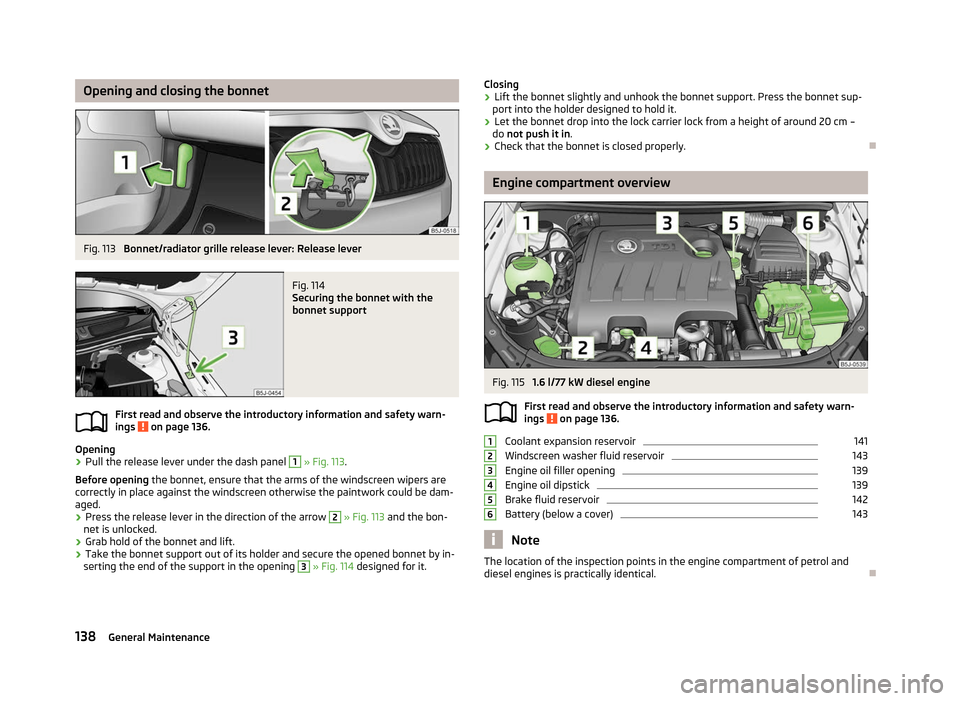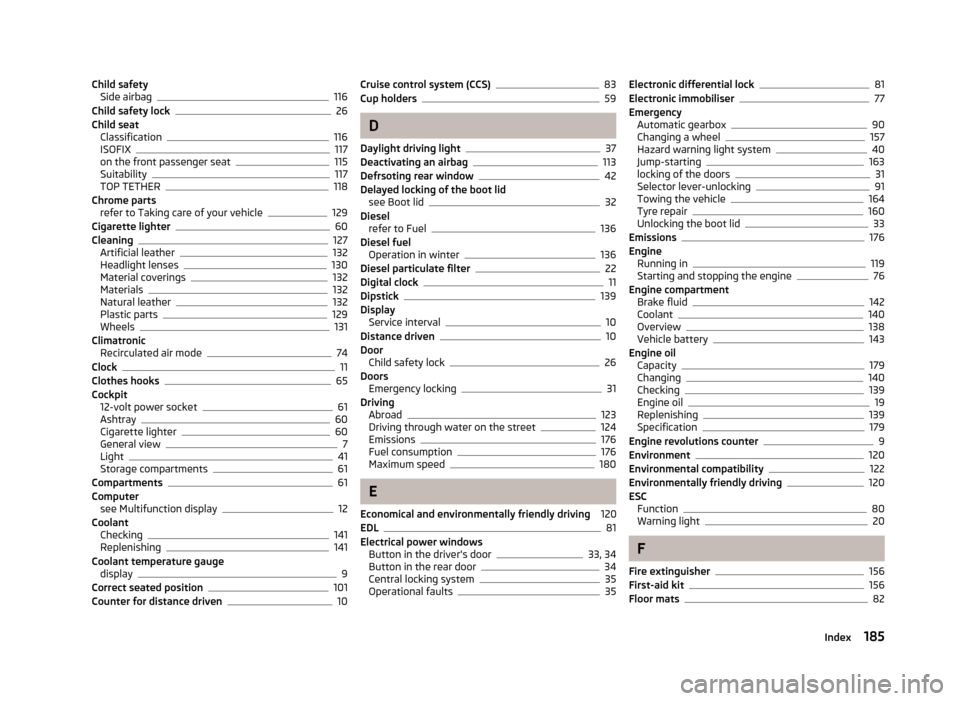oil dipstick SKODA ROOMSTER 2012 1.G Owner's Manual
[x] Cancel search | Manufacturer: SKODA, Model Year: 2012, Model line: ROOMSTER, Model: SKODA ROOMSTER 2012 1.GPages: 194, PDF Size: 4.8 MB
Page 140 of 194

Opening and closing the bonnet
Fig. 113
Bonnet/radiator grille release lever: Release lever Fig. 114
Securing the bonnet with the
bonnet support
First read and observe the introductory information and safety warn-
ings on page 136.
Opening
› Pull the release lever under the dash panel 1
» Fig. 113.
Before opening the bonnet, ensure that the arms of the windscreen wipers are
correctly in place against the windscreen otherwise the paintwork could be dam-
aged.
› Press the release lever in the direction of the arrow 2
» Fig. 113 and the bon-
net is unlocked.
› Grab hold of the bonnet and lift.
› Take the bonnet support out of its holder and secure the opened bonnet by in-
serting the end of the support in the opening 3
» Fig. 114 designed for it.
ä Closing
› Lift the bonnet slightly and unhook the bonnet support. Press the bonnet sup-
port into the holder designed to hold it.
› Let the bonnet drop into the lock carrier lock from a height of around 20 cm –
do not push it in .
› Check that the bonnet is closed properly. Ð Engine compartment overview
Fig. 115
1.6 l/77 kW diesel engine
First read and observe the introductory information and safety warn-
ings on page 136.
Coolant expansion reservoir 141
Windscreen washer fluid reservoir 143
Engine oil filler opening 139
Engine oil dipstick 139
Brake fluid reservoir 142
Battery (below a cover) 143
Note
The location of the inspection points in the engine compartment of petrol and
diesel engines is practically identical. Ð
ä 1
2
3
4
5
6
138
General Maintenance
Page 141 of 194

Checking the engine oil level
Fig. 116
Dipstick
First read and observe the introductory information and safety warn-
ings on page 136.
The dipstick indicates the level of oil in the engine
» Fig. 116.
Checking the oil level
› Ensure that the vehicle is positioned on a level surface and the engine has
reached its operating temperature.
› Switch off the engine.
› Open the bonnet.
› Wait a few minutes until the engine oil flows back into the oil sump and remove
the dipstick.
› Wipe the dipstick with a clean cloth and insert it again to the stop.
› Then pull the dipstick out again and check the oil level.
Oil level within range A
›
No oil must be refilled.
Oil level within range B
›
Oil can
be refilled. It is possible that the oil level may then be within range A
after doing this.
Oil level within range C
›
Oil must be refilled. It is sufficient, once this is done, to keep the oil level within
range B
.
It is normal for the engine to consume oil. The oil consumption may be as much as
0.5 l/1 000 km depending on your style of driving and the conditions under which
you operate your vehicle. Consumption may be slightly higher than this during the
first 5 000 kilometres. ä
One should therefore check the oil level at regular intervals, preferably every time
after the fuel tank is filled or after driving for long stretches.
We recommend maintaining the oil level within the range A
, but not above
, if
the engine has been operating at high loads, for example, during a lengthy motor-
way trip during the summer months, towing a trailer or negotiating a high moun-
tain pass.
The warning light in the instrument cluster will indicate whether the oil level is
too low » page 19 , warning light . In this case, check the oil level with the
dipstick, as soon as possible. Add oil accordingly. CAUTION
■ The oil level must on no account extend beyond the range A
» Fig. 116. Risk of
damaging the exhaust system!
■ If it is not possible to top up the engine oil under the prevailing conditions, do
not continue your journey! Switch off the engine and obtain professional assis-
tance from a ŠKODA specialist garage, otherwise it could cause severe engine
damage. Note
Engine oil specifications » page 179. Ð Replenishing the engine oil
First read and observe the introductory information and safety warn-
ings on page 136.
›
Check the engine oil level
» page 139.
› Unscrew the cap of the engine oil filler opening.
› Replenish the oil in portions of 0.5 litres in accordance with the correct specifi-
cations » page 179, Specifications and engine oil capacity .
› Check the oil level
» page 139.
› Carefully screw on the oil filler opening cap and push the dipstick in fully. Ð
ä
139
Inspecting and replenishing
Page 187 of 194

Child safety
Side airbag 116
Child safety lock 26
Child seat Classification 116
ISOFIX 117
on the front passenger seat 115
Suitability 117
TOP TETHER 118
Chrome parts refer to Taking care of your vehicle 129
Cigarette lighter 60
Cleaning 127
Artificial leather 132
Headlight lenses 130
Material coverings 132
Materials 132
Natural leather 132
Plastic parts 129
Wheels 131
Climatronic Recirculated air mode 74
Clock 11
Clothes hooks 65
Cockpit 12-volt power socket 61
Ashtray 60
Cigarette lighter 60
General view 7
Light 41
Storage compartments 61
Compartments 61
Computer see Multifunction display 12
Coolant Checking 141
Replenishing 141
Coolant temperature gauge display 9
Correct seated position 101
Counter for distance driven 10Cruise control system (CCS) 83
Cup holders 59
D
Daylight driving light 37
Deactivating an airbag 113
Defrsoting rear window 42
Delayed locking of the boot lid see Boot lid 32
Diesel refer to Fuel 136
Diesel fuel Operation in winter 136
Diesel particulate filter 22
Digital clock 11
Dipstick 139
Display Service interval 10
Distance driven 10
Door Child safety lock 26
Doors Emergency locking 31
Driving Abroad 123
Driving through water on the street 124
Emissions 176
Fuel consumption 176
Maximum speed 180
E
Economical and environmentally friendly driving 120
EDL 81
Electrical power windows Button in the driver's door 33, 34
Button in the rear door 34
Central locking system 35
Operational faults 35Electronic differential lock 81
Electronic immobiliser 77
Emergency Automatic gearbox 90
Changing a wheel 157
Hazard warning light system 40
Jump-starting 163
locking of the doors 31
Selector lever-unlocking 91
Towing the vehicle 164
Tyre repair 160
Unlocking the boot lid 33
Emissions 176
Engine Running in 119
Starting and stopping the engine 76
Engine compartment Brake fluid 142
Coolant 140
Overview 138
Vehicle battery 143
Engine oil Capacity 179
Changing 140
Checking 139
Engine oil 19
Replenishing 139
Specification 179
Engine revolutions counter 9
Environment 120
Environmental compatibility 122
Environmentally friendly driving 120
ESC Function 80
Warning light 20
F
Fire extinguisher 156
First-aid kit 156
Floor mats 82
185
Index